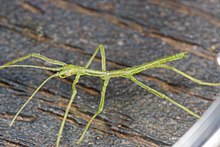| Megaphasma denticrus | |
|---|---|

| |
| Scientific classification | |
| Domain: | Eukaryota |
| Kingdom: | Animalia |
| Phylum: | Arthropoda |
| Class: | Insecta |
| Order: | Phasmatodea |
| Family: | Diapheromeridae |
| Subfamily: | Diapheromerinae |
| Genus: | Megaphasma |
| Species: | M. denticrus |
| Binomial name | |
| Megaphasma denticrus (Stål, 1875) | |
Megaphasma denticrus, the giant walkingstick, is a species of phasmid or stick insect in the family Diapheromeridae. They inhabit a range spanning wooded areas of Texas, Oklahoma, and parts of Mexico.
Description
It is the largest insect in North America, growing up to 7 inches in length. Giant walkingsticks exhibit sexual dimorphism, with females generally being significantly larger than males. Giant walkingsticks have spines on their middle and hind legs; males have only a single, larger spine on each hind leg. Giant walkingsticks vary in color from shades of green to brown. Males also tend to be more brightly colored than females.
Distribution
The giant walkingstick can be found as far east as Indiana, Alabama, and Kentucky; north to Wisconsin; west to New Mexico; and south to Mexico. However, they can be found most commonly in wooded areas of Texas, Oklahoma, and parts of Mexico.
Ecology
Giant walkingsticks' preferred habitat and diet includes grass, grapevines, oak trees, elms, and mesquites. The insects eat the foliage of these plants, and use camouflage to blend into the woody parts of their habitat. Unusually large groups of this species were observed in June 1981 and June 2000 in Texas, though an exact cause of these groupings has not been determined.
Reproduction
This species can reproduce sexually or asexually. Research suggests that sexually reproducing females lay more eggs than their asexual counterparts, although this pattern only seems to emerge among older individuals. The resulting ploidy of asexual reproduction is not well understood in this species. The eggs of this species have a two year incubation period. Despite this long incubation period, adults of this species only have a lifespan of approximately 50 days.
Individual females of this species also commonly exhibit polygyny.
Taxonomy
The holotype of this species was described by Carl Stål in 1875 in Louisiana, and is now stored in the Swedish Museum of Natural History. The name "denticrus is derived from the latin "den" (tooth) and "crus" (leg), a reference to the spikes under the species' mesofemur.
References
- "Megaphasma denticrus Report". Integrated Taxonomic Information System. Retrieved 2018-04-22.
- "Megaphasma denticrus species details". Catalogue of Life. Retrieved 2018-04-22.
- "Megaphasma denticrus". GBIF. Retrieved 2018-04-22.
- "Megaphasma denticrus Species Information". BugGuide.net. Retrieved 2018-04-22.
- Otte, Daniel; Brock, Paul (January 2005). "Phasmida Species File: Catalog of stick and leaf insects of the world. Second Edition". The Insect Diversity Association and the Academy of Natural Sciences.
- "Giant Walkingstick". Missouri Department of Conservation. Retrieved 2023-11-30.
- "Walkingsticks". texasinsects.tamu.edu. Retrieved 2023-11-30.
- "Forest Health: Giant Walkingsticks". Texas A&M Forest Service. Texas A&M Forest Service. Retrieved 27 November 2024.
- "Giant walking stick". University of Arkansas Arthropod Museum. University of Arkansas. Retrieved 27 November 2024.
- "Giant Walkingstick". Missouri Department of Conservation. Retrieved 2023-11-30.
- "Giant walking stick". University of Arkansas Arthropod Museum. University of Arkansas. Retrieved 27 November 2024.
- Otte, Daniel; Brock, Paul (January 2005). "Phasmida Species File: Catalog of stick and leaf insects of the world. Second Edition". The Insect Diversity Association and the Academy of Natural Sciences.
- "Giant walking stick". University of Arkansas Arthropod Museum. University of Arkansas. Retrieved 27 November 2024.
- "Giant Walkingstick". Missouri Department of Conservation. Retrieved 2023-11-30.
- "Forest Health: Giant Walkingsticks". Texas A&M Forest Service. Texas A&M Forest Service. Retrieved 27 November 2024.
- Maginnis, Tara; Redmond, Christopher (February 2013). "Sexual vs Asexual Reproduction in a Stick Insect (Megaphasma dentricus)". Texas Journal of Science. 65 (1–4): 3–13 – via EBSCOhost.
- Maginnis, Tara (January 2008). "Some observations on the mating behavior of the giant walking stick (Megaphasma dentricus)". Texas Journal of Science. 60 (1): 57–62 – via ResearchGate.
- Brock, Paul; Eades, David; Otte, Daniel; Baker, Ed; Büscher, Thies. "Data for specimen record". Phasmida Species File. Retrieved 27 November 2024.
- MacRae, Ted. "North America's longest insect". Beetles in the Bush. Retrieved 27 November 2024.
| Taxon identifiers | |
|---|---|
| Megaphasma dentricus | |
This Phasmatodea related article is a stub. You can help Misplaced Pages by expanding it. |